Friday, August 04 2017
It may not seem important at the time, but when we are caught up in the excitement of acquiring a new cycad for our collections, most of us would not give a thought of recording the information that may accompany that acquisition. All too often I’ve been asked to broker the sale of a private collection that has no comprehensive list or inventory recorded. This makes the job of identification increasingly difficult, especially with the addition of so many single and multi-generation hybrids that are being produced by hobbyists and growers alike. Since most private collections I have encountered do not have plant ID tags, I identify each plant as best as I can. Typically I feel comfortable with about 80-85% of my identifications, but I almost always come upon a few potential hybrids or species that I have never seen before. It has become a standard practice for my company to state that all plant identification is ultimately up to the buyer to determine, so as to avoid claims of misrepresentation.
As cycad collectors we should all be aware that, given proper care, nearly all cycads have the potential to outlive us and many generations of our families after us. Since cycads tend to gain significant value with the passing of time, cycad collections that are part of an estate are often viewed as a valuable asset. However few people other than collectors are willing to care for them. For this reason older cycads (if it were known) have likely had several homes in their long lives. With that in mind it is important that we as cycad stewards leave our collections in order. (See “Are You a Good Cycad Steward?” blog from September 2012) It is like writing a will; no one wants to think about doing it, but it helps to ensure that the plant material will be properly taken care of. There will be the day when either a non-plant person or an experienced cycad collector will be either taking over the care of your collection, or examining it for the purposes of buying or brokering it. One of the most important means of making sure your cycads will continue their journey to their next steward is a cycad collection inventory. This is important whether you have a significant and valuable collection, a modest younger collection of seedlings, or something in between,
The Essentials of a Comprehensive Cycad Inventory
- Plant Identification (Genus and species)
- Source (who gave, sold, traded, where was it collected)
- Date Acquired (even if you can only supply the year)
- Size of caudex when acquired (diameter and/or height)
- Plant Sex (if known)
- Year of seed germination (if known)
- Any significant features (characteristics that may be out of the ordinary)
- Amount paid (This may be noteworthy for any future plant or offset sale.)
- Photo ID and description of where the plant may be found, if in the ground. May also be helpful if plant is in a pot.
You may not choose to record all of the categories listed above, and you may wish to add some of your own, if they are not listed. However, it is important to record as much useful information as possible.
I would like to make a special note regarding #9 above. You may wish to produce your cycad provenance/inventory in the form of a video, whereby you digitally record an audio and video record of the individual plants in your collection, as well as a visual record of the plant’s location in the garden.
And last, but certainly not least, it is important to identify the provenance of your plants (#2), especially for what I refer to as “The Heritage Plants.” (See “The ‘Heritage Cycad’ Advantage” blog from May 2012) These are plants that are known to have come out of habitat. They are the survivors that have endured all that nature offers. They have good genes, and haven’t been pampered all their lives with the many advantages of human cultivation.
Proper cycad provenance records are useful to cycad culture in general, and to assist those who come after you in selling or caring for your collection. We hope the practice of keeping accurate records will improve the efficiency of your stewardship.
Grow and prosper,
Keith and Laurie Huber
Monday, May 15 2017
Following one of the most abundant rainy seasons that we have had in many years, I am seeing many mature cycads that look as if they are primed to produce significant growth in the form of leaves or cones. As I am located in southern California, nearly every year my Encephalartos princeps are one of the earliest species to flush new leaves. Of the seven E. princeps that I have growing in the ground, at least four plants have flushed new leaves or are in the process of doing so. The other three may cone later in the year or just grow in the caudex (trunk) or root areas.
Growth in the area of caudex and roots is often overlooked in terms of development. I often hear collectors converse about their plants and state that their cycads had not set any new leaves or produced cones in the past year or two on plants that look to be healthy. This observation is often misleading. Many growers of cycads consider new leaves or cones to be the only significant growth that cycads exhibit. Since a new set of leaves and cone production are relatively spectacular events, it is easy to overlook the less obvious. Equally important and less spectacular are root and trunk growth. The roots and trunk are the necessary prerequisites to a robust healthy cycad. This year’s deep soak rains should make a significant impact on gardens throughout SoCal. Cycads should show considerable progress in all phases of growth.
For all cycads in the ground before the seasonal rains arrive (late fall through spring), I generally try to top dress and turn into the soil some organic fertilizer. If I don’t get any fertilizer down before the rains have completed their seasonal cycle, I may not see significant growth benefits until the following season. Since cycads are survivors and can be very forgiving, any organic food, even if administered late in the season, will likely eventually be beneficial to the plant.
Conversely I recommend that growers feed, plants both in the ground as well as in pots, in the warm months of the year. (Typically between March and September.) Although I prefer organic fertilizer for plants in the ground, I do use chemical water soluble fertilizer for juvenile potted plants. As always, if you are using chemical fertilizer, follow the manufacturer’s recommendations. In time you may eventually gain familiarity with your chosen fertilizer products and their benefits and results. Perhaps at that time you may choose to experiment as needed with the frequency and dosage. Bear in mind that chemical fertilizers can be a two-edged sword. If used properly, they can be beneficial to your plants, and just the opposite is true if you over fertilize with your water soluble chemical fertilizer.
Organic fertilizers, on the other hand, are far more forgiving. It would usually take a sizeable miscalculation in the application of organic fertilizer to cause serious damage. Just bear in mind that doubling your fertilizer in any application doesn’t mean that your plants will grow twice as fast. Moderation is a good policy.
All the best this growing season.
Grow and prosper,
Keith
Thursday, February 09 2017
As we are nearing the last half of the winter season, I find myself beginning to stir with the anxiety and inspiration of going to work in the garden, or, as I call it, “gardinspiration.” I will briefly outline some of the annual tasks that I try to incorporate into my late winter and early spring maintenance program.
This year we have had the blessing of an abundance of rainfall. It has been so long since we have had this much rain that I have almost forgotten the list of tasks that accompany this windfall. In southern California, where I have my nursery, the rains are frequently in tandem with high winds. This combination often introduces an abundance of small to medium sized broken branches and fallen leaves of many varieties to the grounds. I try to remove fallen branches and larger palm fronds as soon as possible, in order to minimize any damage they may have caused to understory plants. Additionally, the much needed moisture from rain benefits the endless variety of weeds that seem to appear as effortlessly as the gentle breezes that help to spread their seeds. Granted staying ahead of the weeds is a year round challenge, but after rains, it seems to be magnified.
One of the many inevitable maintenance chores that heavy rains and winds cause is the need to repair and rebuild the circular earthen basins that many growers create to help concentrate water and fertilizer around the base of cultivated garden plants. These basins are a must in an area where palm and cycad growers often plant their material on mounds or on sloped hillsides. They can be made of the indigenous soil, but often incorporate boulders and a variety of rocks for added structure. These basins are necessary to conserve water the rest of the year by minimizing downhill runoff. The dimensions will vary with the age of the plant, but as a general rule, if you can, for smaller plants, make the basin diameter approximately twice the length of a typical leaf. Larger plants can benefit from basins from a minimum of four to eight times the diameter of the cycad caudex (trunk). This number is variable, because it is somewhat dependent on the size of the root system. Therefore as plants reach maturity, it is not a bad idea to try to gradually enlarge the basins.This garden repair coincides with the time of year that I like to spread mulch and mix into the soil of my basins a variety of fertilizer products. This is so that they can be watered into the soil by late winter or early spring.
Pictures left to right:
- Basin softened by wind, rain and hail
- Using a small rake to bring up the soil both withing the well and outside the well
- Basin defined and reshaped
Like many garden chores, these maintenance tasks mentioned above do not have an immediate payback, but rather pay out their dividends during the growing season. It is like cash in the bank that will be earning interest over the next number of months as the weather gets warmer and heads into spring.
Grow and prosper,
Keith
Saturday, January 09 2016
The use of cycads in drought tolerant landscapes is not a new concept. In southern California, most of the collectors that I know, by virtue of their interest in growing the unusual, have a unique blend of cycads, palms, and succulents in their gardens. Perhaps without even trying, they have included one, if not several, of the plant families that are known to tolerate infrequent irrigation/drought conditions. Until recent years, the use of drought tolerant plant material had been simply one of the many choices that one could select when deciding upon a landscape solution for residential or commercial applications. However, with recent water shortages and rationing issues faced by many in the western and south western regions of the U.S., there has been a movement away from the use of plant material that requires heavy irrigation, and toward drought tolerant solutions.
This past summer I had the opportunity to design and oversee the transformation of a large commercial property, whose ownership group had chosen to take advantage of a significant monetary incentive, which was provided by their local water district. This monetary award was contingent on the removal of all high water demand landscaping, and replacement with drought tolerant material. The commercial property consisted of approximately 60,000 square feet of office space with a footprint of around 30,000 square feet. Landscape space completely encompassed the structure. Much of its original material, which was installed in the mid ‘80’s, had fairly high irrigation requirements. Water conservation was not a concern at that time.
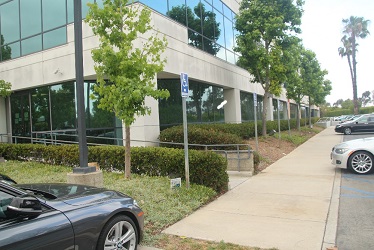
The original landscape was comprised of grass, ivy, deciduous trees, pines, and a variety of shrubs. After most of the original landscape had been removed, a plan was drawn up, and the task of procuring the specified material was undertaken. The acquisition of plant material involved 13 different grower sources over a period of two and a half months. Installation took place during summer, and the old irrigation was modified and upgraded to accommodate the new plant positioning.
As a broker/grower of palms and cycads, I have a good understanding of the unique drought tolerant advantages of many species of cycads, palms, and succulents. This blend of exotic material with similar low water requirements was arranged in such a way as to take advantage of the seasonal changes of sunlight and juxtaposition to compliment the architectural elements of the building. Additionally the character and size of the individual plants was taken into consideration in an effort to create a pleasing and complimentary visual appeal.
This project has proven to me that a drought tolerant landscape does not need to be void of beautiful, exotic, plant material, nor does it necessarily require sacrificing a tropical look. There is such a substantial variety of material that can be used, even the most discriminating of customers can achieve satisfaction with a drought tolerant landscape.
Grow and prosper,
Keith
Wednesday, April 22 2015
Cycads have evolved and adapted to grow in a range of habitats and weather conditions world wide. However, plant species with a variety of shades of blue can be found arid hot habitats. Palms and cycads are just two of the types of plants that can display blue leaf colorations. Succulents and cacti also are heavily represented with a variety of blue shades.
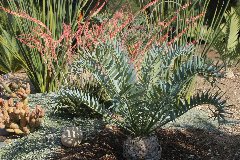 |
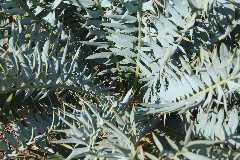 |
| Encephalartos horridus |
Encephalartos horridus close-up |
The blue coloration that is associated with certain plant species is actually due to a thin waxy substance that is produced by the plant to provide some protection from heat and sun exposure. It also helps the plant to retain moisture by protecting the plant from desiccation or excessive transpiration. This waxy substance isn’t actually blue-ish in color, but more in the range of off-white. As a thin coating on the green leaves it gives a visual appearance that the leaves are blue.
The waxy coating can be easily rubbed with your fingers to expose the green leaf beneath. This coating also can begin to wear off naturally from older leaves that have been on the plant for a season or longer.
In the future when we hear the comments from others that “the blues are so beautiful,” perhaps we may realize that their beauty is only skin deep.
Grow and prosper,
Keith
Saturday, February 21 2015
I would like to share information about a valuable garden tool with you. If you do your own maintenance of the palms and cycads that you grow, this tool will likely be used as much as your shovel or rake. I rate this tool very highly on my list of must-have tools for the trade.
A few years ago I was pruning some of the lower leaves of a Phoenix dactylifera that had about five feet of clean trunk. A friend of mine stopped by and happened to see that I was laboring with a small (two foot blade) bow saw. He said that he had a cordless battery powered "Saws All" type of reciprocating saw in the trunk of his car, and he said that he used it for all kinds of pruning and trimming jobs in his yard. He offered it to me to use. Although I have a reciprocating saw of my own, I thought that I would accept his offer, and give it a try. Since I could trim the leaves that needed removal while still standing on the ground, I could control the saw with two hands, but I could not control where the leaves would fall.
After having completed all of the trimming necessary on the Phoenix palm, I began to question myself why I hadn’t used my own reciprocating saw to make the task much easier.
(See Figure 1.) Then it dawned on me why I hadn’t. First of all my reciprocating saw is not powered with a rechargeable battery, so a long extension cord is needed. Secondly it is so large that it requires both hands to safely operate. Since I was standing comfortably with both feet on the ground, I was able to use both hands to operate and control the standard size reciprocating saw that my friend had loaned me. But more often than not, when I prune palm or cycad leaves, I prefer to use one hand to hold on to and control the leaf being cut and the other hand to control the cutting instrument (pruner, or bow saw, etc.). Often there are smaller plants nearby that I do not want damaged by falling leaves. To further complicate the cutting process I am occasionally standing on a ladder to access the lower leaves of my cycads. Oh, sorry, that was an “in my dreams” Freudian slip. I meant to say “lower leaves of my palms” instead of “cycads.”
| 1 - Electric Reciprocating Saw |
2 - Battery Powered One Handed Reciprocating Saw |
3- Pruning Blades and the Additional Larger 12v Battery |
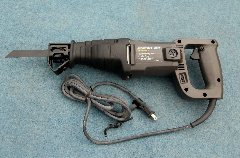 |
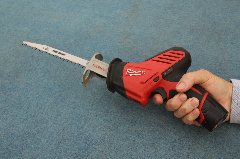 |
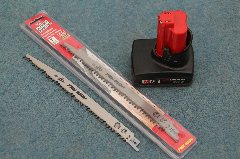 |
Well to make a long story slightly longer, a few months later, I happened to be shopping at a Home Depot (home improvement center), and I decided to take a look at battery powered reciprocating saws. I saw several of the standard sizes and models with battery packs as well as some with power cords. AND THEN I SAW THE GAME CHANGER! (Flashing lights and the sound of trumpets.) This little beauty brought the same twinkle to my eye that Ralphie had when he finally received his beloved Red Rider BB gun in the classic movie Christmas Story. Yes, finally someone had designed a battery powered reciprocating saw that could safely be operated WITH ONE HAND. (See Figure 2.) Thank you Milwaukee! Although I believe there are other good brands of single hand operational reciprocating saws, I chose the Milwaukee brand, and I have been very happy with its ease of operation and comfortable grip. No, I do not have stock in Milwaukee. (Perhaps I should.)
This model has larger capacity additional batteries available. It also has blades that are designed for pruning, which I prefer, but I have a friend who prefers the smoother cut of the blades that are designed to cut metal. (See Figure 3.) I believe that he said that the finer teeth of the metal cutting blades tend to leave a smoother cut surface on the petiole (leaf bases) of his palms and cycads. I think that the coarser cut surface that occurs with the standard pruning saw blades is just fine for me, and its coarser teeth seem to cut through the palm and cycad leaf bases faster.
It is also worth mentioning that the smaller saw can be operated comfortably with either hand. This is helpful because the user fatigue factor between the larger reciprocating saw and its smaller, lighter counterpart is significant, especially if you are putting in an extended time period of pruning. (See Figure 4.)
| 4 - Size Comparison of Electric and Battery Powered Reciprocating Saws |
5 - Clockwise from top - Tote Bag, Larger Battery, Pruning Blades, Saw with Smaller Battery Inserted, Charger Stand |
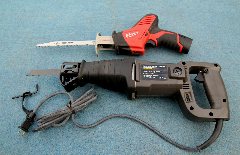 |
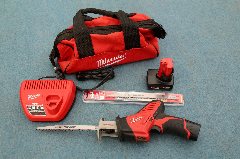 |
Along with the saw motor and its gripping assembly, a small rechargeable12 volt lithium ion battery is included, and is already plugged into the handle grip in these photos. Also included is a battery charger stand. Milwaukee also provides a handy canvas tote bag for storage and transport convenience. I purchased separately pruning blades, as well as an additional (larger) rechargeable 12 volt lithium ion battery, so that I could alternately change out and recharge batteries as needed. (See Figure 5.) I am not sure where prices are now, but I paid about $220.00 for the six items mentioned above. Milwaukee provides packets of saw blades for varying applications, as well as additional batteries, and they are sold separately.
I would have to say that the time I save with this single hand reciprocating saw is at least one half as much time as would be needed if I were using pruners, loppers, or a bow saw. The time saved makes for a pretty rapid payback, if you have a modest to large garden to maintain.
Grow, prune, and prosper,
Keith
Saturday, August 09 2014
Taking off the cycad pups or cycad "babies" is one of the ways to propagate new cycads. Over the years I have developed a number of techniques for pup removal that have resulted in growing healthy cycads. Below I am sharing a video which gives you a brief overview of the process.
>
If you would like the step by step detailed instructions, we have a DVD available. CLICK HERE
Sunday, February 02 2014
I am often asked what to look for when buying a cycad. For me, there are several things that come to mind that I feel are important criteria. First of all I usually look at the overall appearance to try to determine the general health of the plant. Of course you want a nice looking plant. However cycads can be deceiving at times. Occasionally a healthy cycad can look somewhat scraggly if it has recently been subjected to hail or windy conditions. This can cause the leaves to look a little beat up, but often this is something that the plant will rectify when a new flush of leaves is produced in spring or early summer.
The next thing that I will look at is how large the caudex or trunk of the cycad is. This portion of the plant is an essential element. It is the source of both the leaves of the cycad and the roots as well. It is where water and food is stored for times of drought. The size of the caudex will also give a good idea of how many leaves can be produced and also whether the plant is a juvenile plant of has reached or is approaching adult or coning size.
Cones on cycads are the reproductive structure that enable seed production to take place. Cycads are dioescious, which means that each plant is either a male or a female plant for the duration of its life. If a cycad is coning age (usually 10-20 years old), it usually has reached nearly “full footprint,” or it has nearly reached its full diameter. Diameter of the caudex is very important, because the larger it is, the fuller the flushes of leaves it can produce, and the greater the capability for producing multiple cones, or coning more frequently. As always budget comes into the picture, and you should purchase the biggest caudex that you can afford at the time.
Finally I will squeeze the main caudex and any of its visible offsets (pups) with inward pressure of both hands to determine whether the caudex is firm or somewhat mushy, or gives way under compression. If it does compress, I would not invest in that plant. It likely is suffering from any of a number of conditions that generally are not healthy.
The roots are the portion of the cycad that are the most difficult to assess, since they are out of sight. There is little that can be done to determine their condition. You can very gently move aside some of the soil and spot check the top portion of the roots to inspect their health. If all else looks good and feels firm, the odds are that the plant is healthy.
Grow and Prosper,
Keith
Tuesday, November 26 2013
Perhaps the time has come, or is even past due, for people in the trade, in the societies, and those who are simply enthusiasts to consider a campaign to change the name “Sago Palm” to “Sago Cycad.” On the face of it, it doesn’t seem like it’s any big deal to keep it as is, after all, it’s just a name, right? And a nickname at that.
Well, let’s take a closer look. First of all I can’t tell you how many people in southern California own Sago Palms, but have never heard the term “cycad.” Additionally they don’t realize that they actually own one of the most popular species of cycads in the world. Perhaps many of you have had people ask, “What is a cycad,” but they are familiar with a “Sago Palm.” Or you may have noticed some people who may have heard the word “cycad,” but they just can’t quite remember how to say it, and call it a “cy-ad.” The term “palm” added to the name of perhaps the best known cycad is not only misleading, but does nothing to inform or educate the public that cycads are different from palms.
I am fortunate to be serving on the board of the U.S Cycad Society. I was recently (October 2013) appointed to chair the Education Committee, and after thoughtful consideration, I felt compelled to make one of my first orders of business to start a campaign to correct this longstanding misnomer from “Sago Palm” to “Sago Cycad,” or to use it’s botanical name “Cycas Revoluta.” This simple correction can do wonders to educate the general population as well as those already in the nursery industry. And this is perhaps the first and most important step in helping the public to appreciate these amazing prehistoric plants.
Somehow it seems to be an ironic disservice that the most popular and most well known cycad in the world is saddled with a common name that describes it as a palm. I feel quite certain that there is no palm with a common name that describes it as a cycad. “Sago Palm” was probably coined as a convenient reference term that reflected the plant’s appearance and similarity to a palm, and I believe that there was probably no intent to deceive by early nurserymen and growers when the moniker was adopted. However, at the risk of appearing to rock the boat, I believe that reliable data, when known, should trump all previous data or information, if it is truthful. Nearly all other cycads (with only a few exceptions) are referred to by their botanical name. But if changing the common name of “Sago Palm” to its more descriptive name, “Cycas revoluta,” is just too much to swallow, and is too big of a jump for the general public, who usually prefer the common name, then its reference could always defer to a “new” common name of “Sago Cycad.” This would be botanically appropriate and would help to give the “Sago Cycad” a more appropriate classification in the world of botany.
Grow and Prosper,
Keith
Sunday, September 29 2013
Nurseries and plant specifiers have been promoting the use of drought tolerant plant material in order to feed the seasonal demand by landscapers, homeowners, and collectors. Reflecting back on the last few years of the market shift to a xerophytic emphasis has shown that cycads can hold their own when used in drought tolerant landscape plantings.
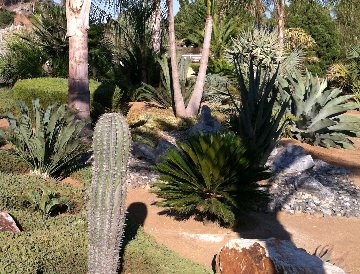
This is, of course, not new information to anyone who has some knowledge of cycad native habitat worldwide. Approximatelyhalf of all known cycad species have significant drought tolerant capabilities. These would consist of cycads whose native habitat is in the dryer regions around the globe. These include many blue Encephalartos species from Africa, many fine leaflet forms of Dioons from Mexico, and many of the Macrozamia species from Australia. Even some species that are native to more tropical or subtropical habitats have shown to be surprisingly resilient when they are established.
Here in southern California many of the larger, more established cycads could actually survive on the seasonal rainfall alone. It is worth noting that larger, more established specimens have developed a mature root system and a significant size caudex (trunk), both of which help to feed and maintain hydration of the plant system during times of drought.
Cycads have proven their versatility when combined with tropical theme landscaping, as well as xerophytic landscape plantings, and they are always able to maintain their own identity.
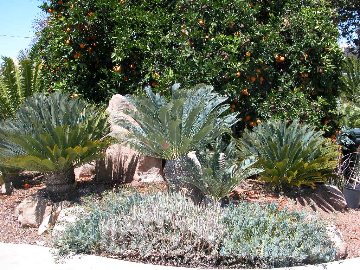
This isn’t to say that all cycads thrive in all positions in the garden. As you study and try various species, you will find that nearly every species would have subtle location preferences if they could make that choice for themselves. As an example, many of the green species of Encephalartos can be grown in full sun if there is significant humidity in the air and little or no seasonal frost. While that same plant, in a dryer, warmer location may benefit from receiving just morning sun for half a day, and then receiving partial or full shade for the remaining part of the day. Plant placement is a subtle but significantly important variable that is worth consideration at the time of planting. As always try to group plants of compatible material that will have similar water requirements.
Grow and prosper,
Keith
|
|
|